Chapter: 10th Science : Chapter 5 : Acoustics
Reflection of Sound
REFLECTION OF SOUND
When you speak in an
empty room, you hear a soft repetition of your voice. This is nothing but the
reflection of the sound waves that you produce. Let us discuss about the
reflection of sound in detail through the following activity.
When sound waves travel
in a given medium and strike the surface of another medium, they can be bounced
back into the first medium. This phenomenon is known as reflection. In simple
the reflection and refraction of sound is actually similar to the reflection of
light. Thus, the bouncing of sound waves from the interface between two media
is termed as the reflection of sound. The waves that strike the interface are
termed as the incident wave and the waves that bounce back are termed as the
reflected waves, as shown in Figure 5.3
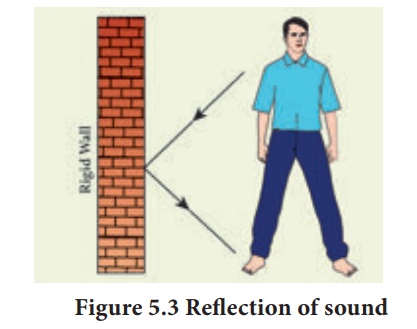
1. Laws of reflection
Like light waves, sound
waves also obey some fundamental laws of reflection. The following two laws of
reflection are applicable to sound waves as well.
·
The incident wave, the normal to the reflecting surface and the
reflected wave at the point of incidence lie in the same plane.
·
The angle of incidence ∠i is equal to the angle
of reflection ∠r.
These laws can be
observed from Figure 5.4.
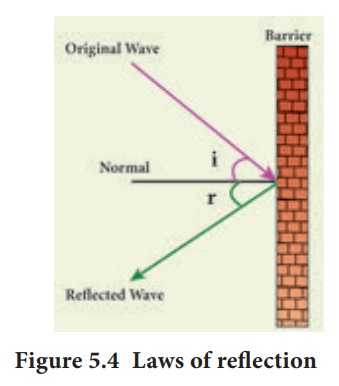
In the above Figure 5.4,
the sound waves that travel towards the reflecting surface are called the
incident waves. The sound waves bouncing back from the reflecting surface are
called reflected waves. For all practical purposes, the point of incidence and
the point of reflection is the same point on the reflecting surface.
A perpendicular line
drawn at the point of incidence is called the normal. The angle which the
incident sound wave makes with the normal is called the angle of incidence,
‘i’. The angle which the reflected wave makes with the normal is called the
angle of reflection, ‘r’.
2. Reflection at the boundary of a denser medium
A longitudinal wave
travels in a medium in the form of compressions and rarefactions. Suppose a
compression travelling in air from left to right reaches a rigid wall. The
compression exerts a force F on the rigid wall. In turn, the wall exerts an
equal and opposite reaction R = – F on the air molecules. This results in a
compression near the rigid wall. Thus, a compression travelling towards the
rigid wall is reflected back as a compression. That is the direction of
compression is reversed (Figure 5.5).
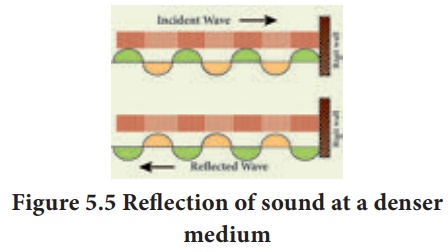
3. Reflection at the boundary of a rarer medium
Consider a wave
travelling in a solid medium striking on the interface between the solid and
the air. The compression exerts a force F on the surface of the rarer medium.
As a rarer medium has smaller resistance for any deformation, the surface of
separation is pushed backwards (Figure 5.6). As the particles of the rarer
medium are free to move, a rarefaction is produced at the interface. Thus, a
compression is reflected as a rarefaction and a rarefaction travels from right
to left.
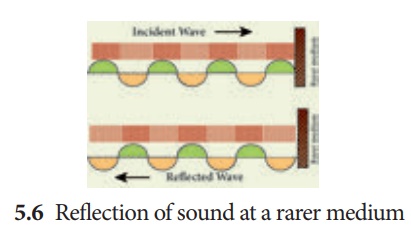
4. Reflection of sound in plane and curved surfaces
















When sound waves are
reflected from a plane surface, the reflected waves travel in a direction,
according to the law of reflection. The intensity of the reflected wave is
neither decreased nor increased. But, when the sound waves are reflected from
the curved surfaces, the intensity of the reflected waves is changed. When
reflected from a convex surface, the reflected waves are diverged out and the
intensity is decreased. When sound is reflected from a concave surface, the
reflected waves are converged and focused at a point. So the intensity of
reflected waves is concentrated at a point. Parabolic surfaces are used when it
is required to focus the sound at a particular point. Hence, many halls are
designed with parabolic reflecting surfaces. In elliptical surfaces, sound from
one focus will always be reflected to the other focus, no matter where it
strikes the wall.
This principle is used
in designing whispering halls. In a whispering hall, the speech of a person
standing in one focus can be heard clearly by a listener standing at the other
focus.
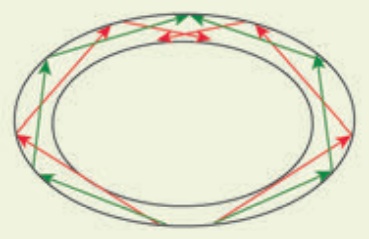
Related Topics